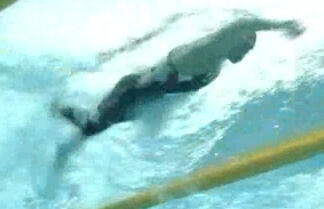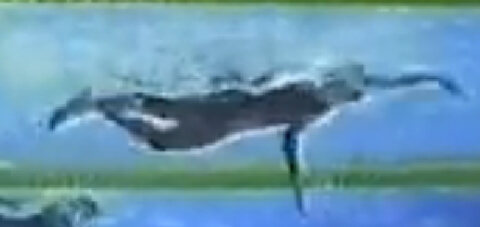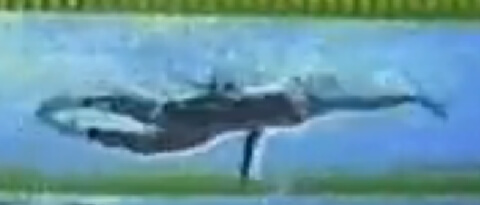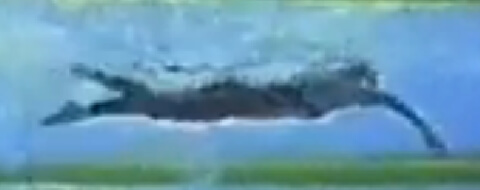Science of Performance: Hand Entry III
By G. John Mullen of SwimmingScience.net and CenterofOptimalRestoration.com, Swimming World correspondent
Note: In case you missed them, here's Part I and Part II.
SANTA CLARA, California, November 23. EXCELLENT hand position, entry, "feel" and catch are essential for elite swimming. Unfortunately, the common bent arm recovery is not for everyone. The bent arm recovery requires large amounts of forearm strength and stability to maintain proper hydrodynamics. Luckily, there are stroke variations to enhance athlete's strengths and weaknesses. These various entries are utilized by swimmers for different race lengths or at different parts of the same race (I know, multiple forms of freestyle in one race…sounds complicated!).
Mike Bottom teaches most of his swimmers three different styles of freestyle. He feels elite swimmers use different techniques based on different race constraints. These variations are essential, not only giving depth to elite swimmers, but helping swimmers find a stroke best fit for their needs. Swimming is a unique sport, where people of any age can enjoy. Sometimes swimmers don't get tossed into the water until their late teens and have difficulties developing certain aspects of their stroke due to biomechanical or physiological constraints. Other swimmers have come from other sports or were born with certain attributes making them more adept to certain stroke biomechanics. These differences influence stroke technique, luckily, there is no "perfect" entry or initial catch.
Race distance will also alter one's stroke and if you are working with elite swimmers, different stroke techniques are required to endure different distances. Bobby Savulich of Michigan's Team Elite, recently told me learning these freestyle variations were the biggest adjustment in his swimming career. This article will discuss the differences between hand entry and initial catch in two freestyle variations, the bounce and straight arm recoveries. These forms of recovery have various names, but can be seen on every pool deck.
Bounce Recovery
This form of swimming is very similar to the bent elbow recovery, but it utilizes the hips and kicking to drive axial rotation. One may argue that hip motion and kick have nothing to do with the entry and initial catch, but if you watch elite swimmers they perfectly time their kicking with their catch, directly correlating these two variables.
Everyone has seen the bounce freestyle and some have wondered why and how can swimmers go so fast with an unnecessary bounce in their stroke. Many biomechanists feel it is a waste of energy and causes unnecessary displacement during the stroke. No one truly knows the mechanism behind the bouncing freestyle, but many have pondered the phenomena. I feel the bouncing is due to two main things:
1. The initial catch of the bent arm recovery causes a lift phase. This lift phase will raise the body in the water and result in a subsequent fall phase, better known as a bounce.
2. A down kick is simultaneously performed on the same side performing the initial catch. This down kick is often more powerful than the other kicks and is directed towards the bottom of the pool (unlike some of the other kicks directed to the side), causing hip drive and more contribution to the bounce.
These simultaneous motions cause a rise in vertical displacement, potentially giving the swimmer a constant undulation in the water similar to the short axis strokes. Riding higher in the water will decrease the amount of drag as air has a lower drag coefficient compared to water. The bounce will also make a bow wave next to the body, allowing the swimmer to breath with small head rotation.

As you can see, as this elite swimmer performs a down kick and initial catch on the same side just prior to his hand entry on the other side. Pulling down and kicking down on the same side will produce a bounce in the stroke and provide lift. This motion will also cause a rapid rotation of the hips, similar to pitching a baseball. Everyone has a dominant side, whether you are a MLB pitcher or swimmer; this is why some are stronger breathers, pullers, or throwers on one side.
This technique can be taught with drills focusing on perfect timing between the downkicks and hand entries as well as quick rotations, practically jumping forward. These athletes will conserve energy by performing short sprint bouts of axial rotation followed by a long glide phase.
Recommended Athletes: This can used in races 100 meters and longer, those with a dominant pulling or breathing side or those with a history of baseball, softball or tennis. These athletes need to have good feel in the water and a steady hand during the glide phase.
Straight Arm Recovery
Coach Bottom would insist that this stroke is most beneficial for sprinters since it increases their tempo while optimizing distance per stroke. This stroke generates the most force, as it eliminates the rise phase of the stroke. It can also be used in swimmers with poor "feel" or those who didn't swim until later in their life. These athletes will benefit from a straight arm recovery stroke and to achieve maximum distance per stroke, allowing them to go directly into their initial catch.
If you missed the steps to an "ideal" hand entry and initial catch, read Part I. Now we are going to break down the differences and similarities between the "ideal" high elbow stroke and the straight arm recovery.

When the hand enters in the straight arm recovery the wrist must be flexed. Unlike the bent arm recovery, where the wrist and forearm are in a straight line, wrist flexion will allow a hand first entry. This allows the hand, elbow and shoulder to enter through the same hole, decreasing drag. If this athlete did not enter with their wrist flexed, then their arm would slap the water and cause a red forearm, embarrassment and slow swimming.

Next, the swimmer will maintain their wrist flexion and start to internally rotate their shoulder to get ready for the catch. This position is not much different from the above, but one can note the elbow is slightly higher (improving distance per stroke), and the hand is deeper, suggesting the swimmer is rotating their shoulder to the bottom of the pool to set-up the early vertical forearm.

The swimmer internally rotates their shoulder even more (bringing their hand towards the bottom of the pool) while maintaining their elbow and wrist position. This wrist position is already grabbing water and increasing propulsion, unlike the high elbow recovery which uses a more distinct lift phase. This decreases the amount of bounce resulting into a flatter stroke.

In this position, the elbow begins to flex to achieve an early vertical catch. At this time, the wrist straightens moving the hand into a paddle position. This phase is very similar to the bent elbow recovery position, both looking to achieve an early vertical catch for optimal propulsion.
As you can see, the entry and initial catch are different between the bent elbow and straight arm recovery, but they both result in the same essential aspect for all elite swimmers, an early vertical forearm.
A straight arm recovery will increase force production and limit bounce, maximizing linear velocity essential for anaerobic races (50 meters).
Recommended Swimmers: Those with poor "feel" or shaky hands during the glide phase. Swimmers who started the sport late. Also beneficial for sprinters or those with a fast arm turnover.
Wrap-up
This puts a wrap on the hand entry and feel series. Remember, no size fits all. Also, the more versatile in the various types of freestyle, the more versatile the swimmer will become. Utilize and recommend stroke corrections with the athlete's goals, physiology requirements of their races and biomechanical constraints in mind to maximize each swimmer's potential.
Dr. G. John Mullen is a Doctor of Physical Therapy and a Certified Strength and Conditioning Specialist. At USC, he was a clinical research assistant at USC performing research on adolescent diabetes, lung adaptations to swimming, and swimming biomechanics. G. John has been featured in Swimming World Magazine, Swimmer Magazine, and the International Society of Swim Coaches Journal. He is currently the strength and conditioning coach at Santa Clara Swim Club, owner of the Center of Optimal Restoration and creator of Swimming Science.



